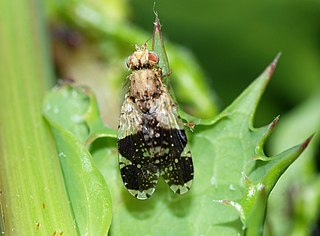
The Bombyliidae are a family of flies. Their common name are bee flies or humbleflies. Adults generally feed on nectar and pollen, some being important pollinators. Larvae generally are parasitoids of other insects.

The Apioceridae, or flower-loving flies, are a small family of flies, all in the single genus Apiocera. They occur mostly in dry, sandy habitats in the deserts of North America, South America, and Australia. Other genera formerly placed in Apioceridae are now in Mydidae.

Tephritis is a genus of flies. It contains around 170 described species, making it the sixth largest genus in the family Tephritidae. Many more undescribed species are known from specimen collections. Tephritis occur throughout much of the world, but most are Palearctic. They can be found in a wide range of climate types, from hot semidesert to tundra. Most species inhabit the inflorescences of plants from several tribes in the family Asteraceae, and a few species cause galls to form.
Philopotinae is a subfamily of small-headed flies. Their larvae are endoparasites of araneomorph spiders in the subgroup Entelegynae.

Panopinae is a subfamily of small-headed flies (Acroceridae). Their larvae are endoparasites of spiders in the infraorder Mygalomorphae.
Pialea is a genus of small-headed flies. It is known from South America.

Anthracinae is a subfamily of bee flies in the family Bombyliidae. There are more than 80 genera and 2,000 described species in Anthracinae.

Acrocera is a genus of small-headed flies in the family Acroceridae. There are around 50 described species in Acrocera.
Aphoebantus is a genus of bee flies. There are at least 80 described species in Aphoebantus.

Ogcodes is a genus of small-headed flies in the family Acroceridae. About 90 species have been described for the genus.

Villini is a tribe of bee flies in the family Bombyliidae. There are about 14 genera and at least 100 described species in Villini.

Eulonchus is a genus of small-headed flies in the family Acroceridae. There are six described species in Eulonchus. The genus is found in North America. Adults have a metallic blue, green or sometimes purple coloration, giving them a jewel-like appearance. A common name for flies in the genus is the North American jewelled spider flies. Adults are also known as "sapphires" or "emeralds".

Turbopsebius is a genus of small-headed flies in the family Acroceridae. There are about four described species in Turbopsebius.
Pterodontia flavipes is a species of small-headed flies. Adult males are 5.5–10.5 mm in size, while adult females are 5–9 mm. The larvae are thought to enter their host spiders at the leg articulations. First instar larvae of the species have also been recorded attacking the mites Podothrombium and Abrolophus.
Ocnaea is a genus of small-headed flies. There are at least 20 described species in Ocnaea.
Lasia is a genus of small-headed flies in the family Acroceridae. There are about 19 described species in Lasia, which are distributed in the New World.
Pterodontia misella is a species of small-headed flies. It is very close in appearance to Pterodontia flavipes, and was considered a synonym of it by Curtis Williams Sabrosky in 1948. However, this synonymy has not been adopted by later authors, and P. misella is still recognised as a distinct species.
Apsona is a genus of small-headed flies. It contains only one species, Apsona muscaria, which is endemic to New Zealand. It is very similar to the North American species Eulonchus smaragdinus.
Leucopsina is a genus of small-headed flies endemic to Australia. Flies in the genus are colored black and yellow, mimicking the appearance of a wasp. Males and females measure 9.0 mm and 12.0 mm, respectively.









